1. Watch this Video
2. Study this Summary
This tutorial first focuses on the ecological and evolutionary consequences of competition, a a “-/-” interaction which occurs whenever two species compete for the same environmental resource. We then turn to the topic of evolutionary arms races that result from predation or parasitism.
But first, we need to define a key ecological term:
Ecological Niche
An ecological niche refers to how an organism makes a living, including its role in the ecosystem and the resources it utilizes.
- Examples of Animal Niches: Apex predator (mountain lion), scavenger (turkey vulture), herbivore (deer), omnivore (grizzly bear), aerial predator (red-tailed hawk), and grazer (bison).
- Examples of Plant Niches: Sun-tolerant trees (oak), shade-tolerant shrubs (rhododendron), salt-tolerant trees (mangrove), desert-adapted plants (cactus), and aquatic plants (water lilies).
Gause’s Competitive Exclusion Principle
This principle states that two species competing for the same niche cannot coexist indefinitely.
- Gause’s Experiment: Different Paramecium species were tested for coexistence.
- Species with different niches (surface foragers vs. bottom dwellers) coexisted.
- Species with identical niches led to competition, with one species outcompeting the other, causing it to become extinct.
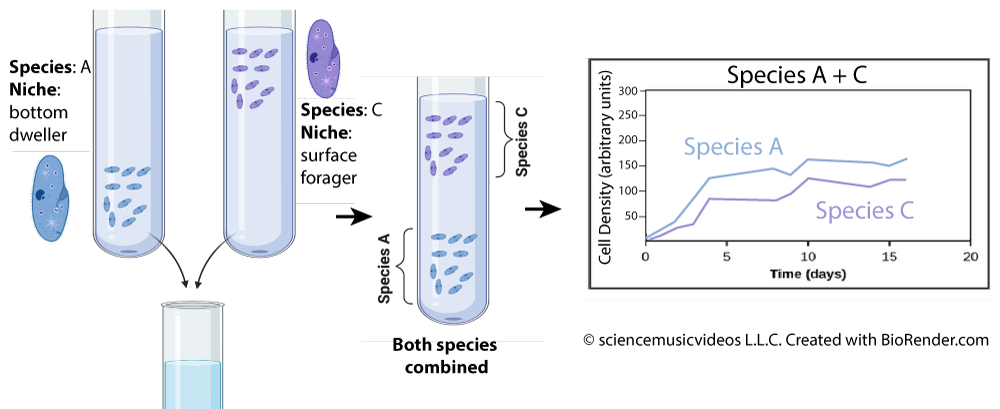 |
 |
Resource Partitioning and Character Displacement
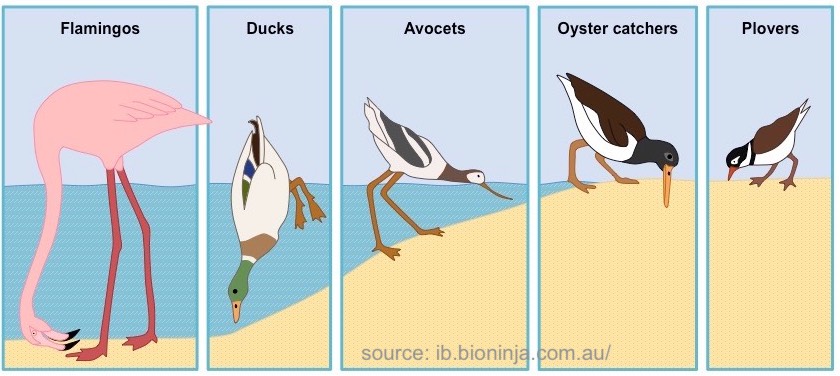
Over evolutionary timespans, competition can lead to specialization, where competing species divide resources in a way that reduces competition. As this occurs, natural selection will lead to character displacement, as individuals that can more effectively exploit a sub-niche will survive and reproduce at higher rates.
- Resource Partitioning: Species evolve to exploit different parts of a resource that’s being competed for.
- Character Displacement: Physical or behavioral traits evolve to minimize competition.
Economic Analogy: Coffee Industry
To help you envision this, here’s an analogy from the coffee industry, where competing companies specialize to best serve specific customer niches:
- Starbucks: Mainstream coffee, sugary specialty drinks.
- Peet’s Coffee: Appeals to coffee purists, dark roasts.
- Philz Coffee: Specializes in pour-over coffee, custom brews.
Ecomorphs and Convergent Evolution
Ecomorphs are morphological forms or types that are connected with a specific ecological niche. For example the diagram below shows ecomorphs of anole lizards are found in forested habitats on the Caribbean Islands. Crown giants are large lizards found in the top of trees. Trunk crown lizards are found lower down.
In any one of the major Caribbean islands, you’ll find these ecomorphs. The ecomorphs in any particular islands are examples of niche partitioning and character displacement: through competition, these lizards have evolved to divide up the resource (the forest). Somewhat astonishingly, the Crown Giants on Jamaica are not closely related to the Crown Giants on Puerto Rico. Rather, the lizards on each island are most closely related to one another, indicating that these ecomorphs arose independently on each island through convergent evolution.
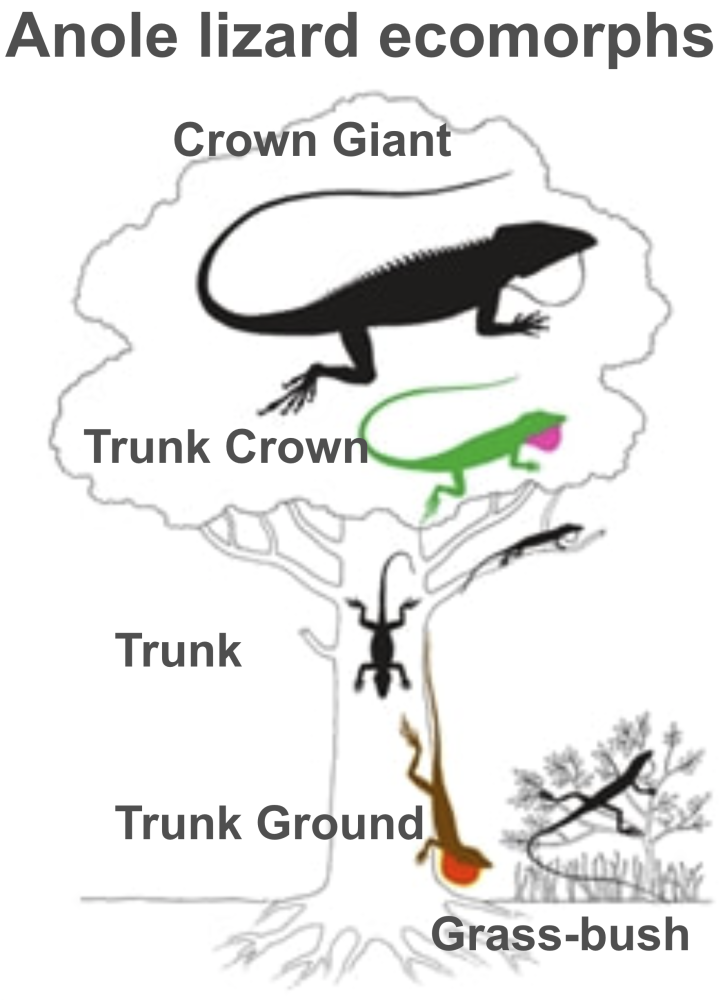 |
|
Character Displacement Case Study: Beak Depth in Galápagos Finches
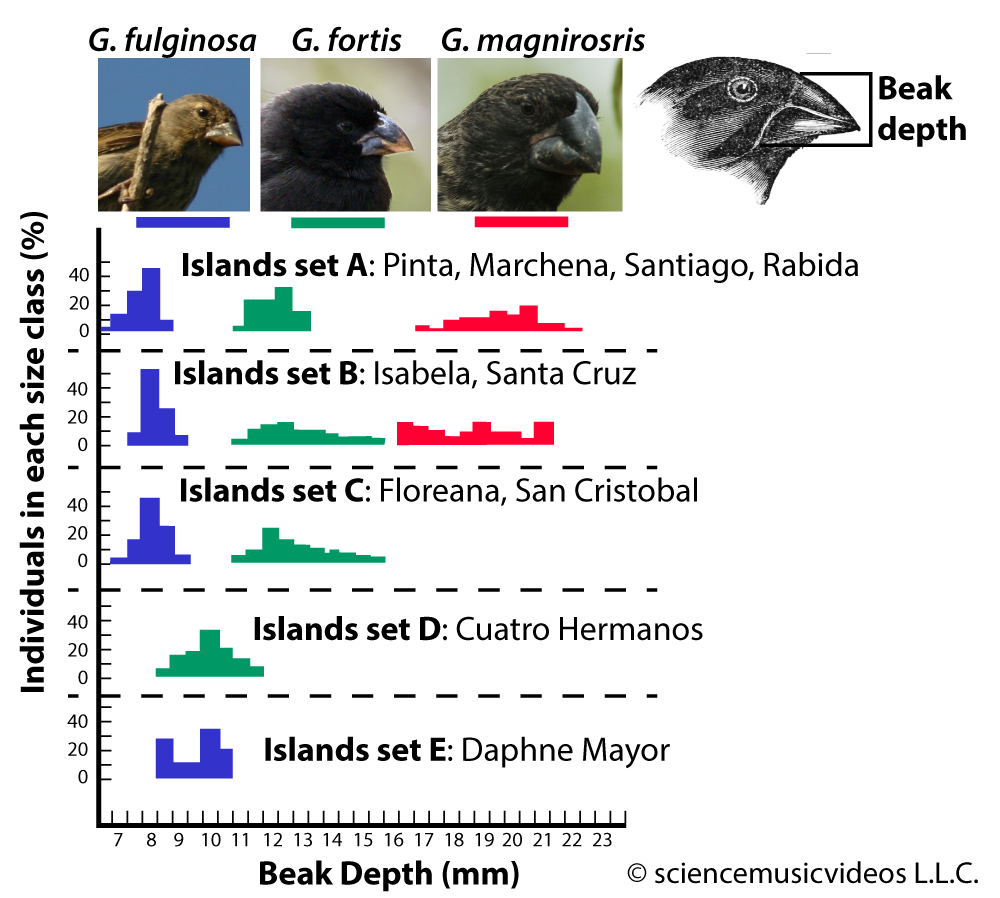
As we’ve seen, competition leads to niche partitioning and character displacement. A great example of the effect of competition can be seen in the data set on the left, which compares beak depth in Galapagos finches that live on the same island (and are therefore competing) and ones where only one species is found on the island (and there’s no competition)
- On islands with multiple finch species: Beak depths do not overlap due to competition that forces each species to specialize on particular food sources.
- On small islands with a single species: Beak depths overlap, as competition is absent, and each species can benefit by filling more of a generalist niche.
Fundamental Niche vs. Realized Niche

The fundamental niche is the full range of resources a species could use, while the realized niche (which results from competition) is what a species actually uses in a competitive environment. The basic idea is that competition reduces a species’ niche, making it narrower.
- Case Study: Intertidal Barnacles
- Species A (higher tide zone) expands its range when Species B is removed, showing its fundamental niche is broader.
- Species B (lower tide zone) does not expand when Species A is removed, meaning its fundamental and realized niches are the same.
Evolutionary Arms Races
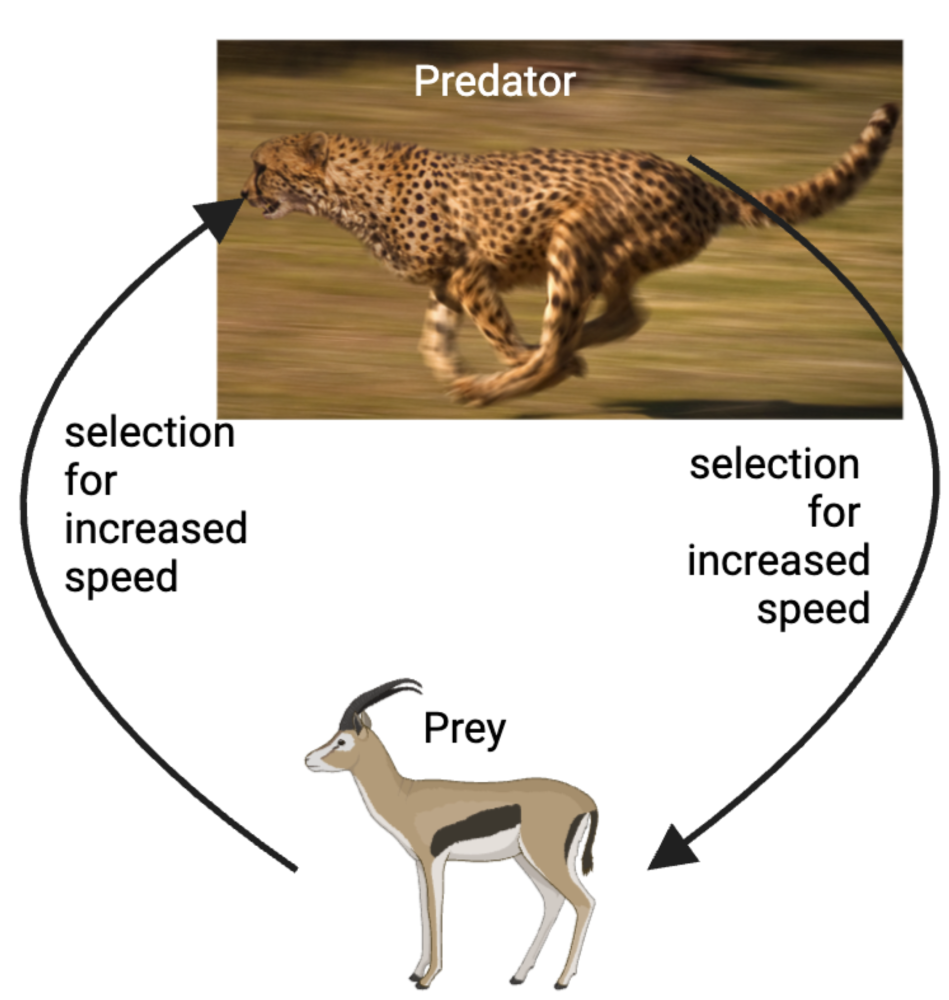
Competition, predation, and parasitism lead to adaptations and counter-adaptations in species.
- Examples of Extreme Adaptations:
- Cheetahs evolve higher speeds as prey animals become faster.
- Camouflaged insects evolve to evade predators with sharp vision.
- Predatory reptiles develop stealth to ambush highly alert prey.
These adaptations highlight the ongoing evolutionary battles that shape life on Earth.
3. Master these Flashcards
[qdeck qrecord_id=”sciencemusicvideosMeister1961-Competition and Coevolution Flashcards, APBioVideoPath”]
[h]Competition and Coevolution
[i]
[q] Define an ecological niche.
[a] An ecological niche refers to how an organism makes a living, including its role in the ecosystem and the resources it utilizes.
[q json=”true” yy=”4″ unit=”8.Ecology” dataset_id=”AP_Bio_Flashcards_2022|10eaac8ad0510″ question_number=”411″ topic=”8.5-6.Community_Ecology_and_Biodiversity”] What is Gause’s competitive exclusion principle?
[a] According to Gause’s principle of competitive exclusion, two competitive species can’t coexist in the same ecological niche. That’s because any advantage that one species has over its competitor will lead the species with the advantage to outcompete the other. In this example, an advantage that species A had over B caused B to become locally extinct.
[q json=”true” dataset_id=”AP_Bio_Flashcards_2022|8a79a7572131b” question_number=”412″ unit=”8.Ecology” topic=”8.5-6.Community_Ecology_and_Biodiversity”] What results from ecological competition?
[a] Because of competition, either one (or more) species will become extinct, or the competing species will evolve in a way to partition the resource that they’re competing for. The result of this niche partitioning is specialization, with simultaneous character displacement so that each species will dominate its sub-niche more effectively. Thus we see, for example, species of shorebirds with different beaks, each one taking a different type of prey.
[q] Define “resource partitioning” and “character displacement.”
[a]
- Resource partitioning occurs when species evolve to exploit different parts of a resource to minimize competition.
- Character displacement is when competing species evolve physical or behavioral traits to minimize competition.
[q] What are ecomorphs? How are ecomorphs connected to the idea of convergent evolution.
[a] Ecomorphs are species that have adapted morphologically to different ecological niches. The presence of similar ecomorphs (that are not closely related) in distinct areas comes about through convergent evolution, as distinct lineages evolve into similar niches. Example: Anole lizards on different Caribbean islands have independently evolved similar ecomorphs.
[q json=”true” yy=”4″ unit=”8.Ecology” dataset_id=”AP_Bio_Flashcards_2022|10d9f07559910″ question_number=”413″ topic=”8.5-6.Community_Ecology_and_Biodiversity”] What’s the difference between a species’ fundamental niche and its realized niche?
[a] The fundamental niche of a species is the range of resources that it could exploit in the absence of competition. However, because species that are competing differentiate (character displacement caused by niche partitioning), the actual set of resources each competing species exploits is narrower than the full resource. The actual resource that’s exploited by each species is the realized niche, and it’s always narrower than the fundamental niche.
[q json=”true” yy=”4″ unit=”8.Ecology” dataset_id=”AP_Bio_Flashcards_2022|10cc42af7e110″ question_number=”414″ topic=”8.5-6.Community_Ecology_and_Biodiversity”] Using the study below involving the barnacle species Chthalamus (A) and Semibalanus (B) as examples, explain the difference between a species’ fundamental niche and its realized niche.
[a] Chthalamus and Semibalanus are two barnacle species found in rocky intertidal zone habitats. When the two species live together, Chthalamus (A) is limited to the uppermost part of the intertidal zone while Semibalanus (B) inhabits the lower parts. If Semibalanus is experimentally removed (2), then Chthalamus will inhabit the entire intertidal zone. CONCLUSION: Chthalamus’s fundamental niche is the entire intertidal zone. Competition limits it to the upper part of the zone, which is its realized niche.
[q] How does competition affect niche size? Use the barnacle study as an example.
[a] Competition reduces the size of a species’ realized niche compared to its fundamental niche.
**Example:** *Chthalamus* barnacles occupy the upper intertidal zone in the presence of *Semibalanus*, but when *Semibalanus* is removed, *Chthalamus* expands its range downward.
[q json=”true” yy=”4″ unit=”8.Ecology” dataset_id=”AP_Bio_Flashcards_2022|111a423dd4110″ question_number=”408″ topic=”8.5-6.Community_Ecology_and_Biodiversity”] Define coevolution. Relate coevolution to the idea of the evolutionary arms race. Provide examples.
[a] Coevolution involves the reciprocal evolutionary adaptations that occur between two or more species. Each species becomes a selective force eliciting counter adaptations in the other species.
Because the two species are involved in a positive feedback loop, the result can be an evolutionary arms race, with extreme reciprocal adaptations in both coevolving species. Examples include the deep tubular flowers of some species and the long proboscis or beak of the moths or birds that pollinate them; the speed of predators and the matching speed of their prey (think of cheetahs and antelopes).
[q] What is an evolutionary arms race? Provide an example.
[a] An evolutionary arms race occurs when predators and prey (or hosts and parasites) evolve counter-adaptations in response to each other.
Example: Cheetahs evolve greater speed, while antelopes evolve to run faster and maneuver more quickly.
[x][restart]
[/qdeck]
4. Tackle these Quizzes
[qwiz style=”width: 650px !important; min-height: 400px !important;” qrecord_id=”sciencemusicvideosMeister1961-Competition and Coevolution Quiz, APBioVideoPath”]
[h]Competition and Coevolution
[i]
[q]As part of his series of experiments about competition, Gause transferred two different Paramecia species with similar niches into the same test tube. Note that in Gause’s experiment, there wasn’t time for the species to evolve into a new ecological niche. All that they could do was compete for the resources. Which of the graphs below shows the most likely outcome?
[textentry single_char=”true”]
[c]ID I=[Qq]
[f]IFRoYXQmIzgyMTc7cyByaWdodC4gVGhlIHR3byBzcGVjaWVzIHdlcmUgaW4gdGhlIHNhbWUgZWNvbG9naWNhbCBuaWNoZS4gSW4gdGhpcyBjYXNlLCBvbmUgc3BlY2llcyAoQSkgaGFkIHNvbWUgYWR2YW50YWdlIHRoYXQgZW5hYmxlZCBpdCB0byBvdXRjb21wZXRlIHNwZWNpZXMgQi4=[Qq]
[c]IEVudGVyIHdvcmQ=[Qq]
[c]ICo=[Qq]
[f]IE5vLiBSZW1lbWJlciB0aGF0IGJvdGggb2YgdGhlc2Ugc3BlY2llcyBzaGFyZSB0aGUgc2FtZSBlY29sb2dpY2FsIG5pY2hlLCB3aGljaCBtZWFucyB0aGF0IHRoZXkmIzgyMTc7cmUgY29tcGV0aW5nIGZvciB0aGUgc2FtZSByZXNvdXJjZXMuIFdoYXQmIzgyMTc7cyB0aGUgbW9zdCBsaWtlbHkgb3V0Y29tZSBpbiB0aGlzIGNpcmN1bXN0YW5jZT8=[Qq]
[q labels = “top”]Fill in the blanks below with your analysis of Gause’s results.
Species A and B both shared the same ecological ___________. Another way to say that is that they consumed the same ____________ within their environments. Because of some unknown _____________, species A was able to _______________ species B, forcing species B into ____________ (within the test tube).
[l]advantage
[fx] No. Please try again.
[f*] Correct!
[l]extinction
[fx] No, that’s not correct. Please try again.
[f*] Great!
[l]niche
[fx] No. Please try again.
[f*] Correct!
[l]outcompete
[fx] No. Please try again.
[f*] Good!
[l]resources
[fx] No. Please try again.
[f*] Good!
[q labels = “top”]Fill in the blanks for Gause’s conclusion: Two species that require the same environmental _____________ cannot occupy the same ecological ________. This idea has come to be known as Gause’s _____________ ____________ principle
[l]niche
[fx] No. Please try again.
[f*] Good!
[l]competitive
[fx] No, that’s not correct. Please try again.
[f*] Good!
[l]resources
[fx] No. Please try again.
[f*] Good!
[l]exclusion
[fx] No, that’s not correct. Please try again.
[f*] Excellent!
[q] Here’s another experiment performed by Gause to study competition. He combined Species A (a bottom dweller) with Species C (which prefers to forage closer to the surface). Which graph represents what happened when these two species were combined in the same test tube?
[textentry single_char=”true”]
[c]ID E=[Qq]
[f]IFRoYXQmIzgyMTc7cyByaWdodC4gRWFjaCBzcGVjaWVzIGhhcyBhIGRpZmZlcmVudCBlY29sb2dpY2FsIG5pY2hlLiBBcyBhIHJlc3VsdCwgd2hlbiB0aGV5JiM4MjE3O3JlIGNvbWJpbmVkIGludG8gdGhlIHNhbWUgdGVzdCB0dWJlLCB0aGV5JiM4MjE3O2xsIGJlIGFibGUgdG8gY29leGlzdC4gU3BlY2llcyBBIHdpbGwgYmUgYWJsZSB0byBmaW5kIGl0cyBmb29kIG9uIHRoZSBib3R0b20gb2YgdGhlIHR1YmUuIFNwZWNpZXMgQyB3aWxsIGZpbmQgaXRzIGZvb2QgY2xvc2VyIHRvIHRoZSBzdXJmYWNlLg==[Qq]
[c]IEVudGVyIHdvcmQ=[Qq]
[c]ICo=[Qq]
[f]IE5vLiBSZW1lbWJlciB0aGF0IHRoZXNlIHNwZWNpZXMgYXJlIGluIGRpZmZlcmVudCBlY29sb2dpY2FsIG5pY2hlcywgd2l0aCBBIGZlZWRpbmcgb24gdGhlIGJvdHRvbSBhbmQgQyBmZWVkaW5nIHRvd2FyZCB0aGUgc3VyZmFjZS4gVGhpbmsgYWJvdXQgcmVzdGF1cmFudHMuIEFzc3VtZSB0aGF0IHlvdXIgdG93biBoYXMgZW5vdWdoIGN1c3RvbWVycy4gVGhlcmUmIzgyMTc7cyBhIHN1Y2Nlc3NmdWwgYnVyZ2VyIGpvaW50IG9uIE1haW4gU3RyZWV0LiBBIE1leGljYW4gcmVzdGF1cmFudCBvcGVucyB1cCB0d28gYmxvY2tzIGF3YXkuIFdoYXQgd291bGQgaGFwcGVuPw==[Qq]
[q]Species A and C have different ecological [hangman]. As a result, when combined into the same test tube, there’s relatively little [hangman] between them. This enables both of these species to [hangman] within the same environment.
[c]bmljaGVz[Qq]
[c]Y29tcGV0aXRpb24=[Qq]
[c]Y29leGlzdA==[Qq]
[q] In the diagram below, which letter indicates the fundamental niche of species A
[textentry single_char=”true”]
[c]IE M=
[f]RXhhY3RseS4gJiM4MjIwO0MmIzgyMjE7IGlzIHRoZSBmdW5kYW1lbnRhbCBuaWNoZSBvZiBzcGVjaWVzIEE=[Qq]
[c]IEVudGVyIHdvcmQ=[Qq]
[c]ICo=[Qq]
[f]IE5vLiBIZXJlJiM4MjE3O3MgYSBoaW50LiBUaGUgZnVuZGFtZW50YWwgbmljaGUgb2YgYSBzcGVjaWVzIGlzIHRoZSByYW5nZSBvZiByZXNvdXJjZXMgaXQgY291bGQgZXhwbG9pdCBpbiB0aGUgYWJzZW5jZSBvZiBjb21wZXRpdGlvbi4gV2hhdCBsZXR0ZXIgc2hvd3MgaG93IEEgZG9lcyB3aGVuIGl0cyBjb21wZXRpdG9yIChCKSBpcyByZW1vdmVkPw==[Qq]
[q] Which diagram (1, 2, or 3) shows the effect of abiotic factors limiting a species’ niche?
[textentry single_char=”true”]
[c]ID M=
[f]TmljZS4gJiM4MjIwOzMmIzgyMjE7IHNob3dzIGhvdyB0aGUgYWJzZW5jZSBvZiBzcGVjaWVzIEEgZG9lc24mIzgyMTc7dCBjaGFuZ2UgdGhlIGRpc3RyaWJ1dGlvbiBvZiBzcGVjaWVzIEIuIElmIGNvbXBldGl0aW9uIGlzbiYjODIxNzt0IGxpbWl0aW5nIEImIzgyMTc7cyBuaWNoZSwgdGhlbiBpdCYjODIxNztzIG1vc3QgbGlrZWx5IGFiaW90aWMgZmFjdG9ycyAoc3VjaCBhcyB0aGUgZHJ5aW5nIGFuZCBzdW5saWdodCBleHBlcmllbmNlZCBpbiB0aGUgdXBwZXIgcGFydCBvZiB0aGUgaW50ZXJ0aWRhbCB6b25lKS4=[Qq]
[c]IEVudGVyIHdvcmQ=[Qq]
[c]ICo=[Qq]
[f]IE5vLiBIZXJlJiM4MjE3O3MgYSBoaW50LiBOb3RlIHdoYXQgaGFwcGVucyB3aGVuIGVhY2ggc3BlY2llcyBpcyByZW1vdmVkLiBXaGljaCBkaWFncmFtIHNob3dzIGEgc2l0dWF0aW9uIHdoZXJlIGEgc3BlY2llcyYjODIxNzsgbmljaGUgaXNuJiM4MjE3O3QgYWZmZWN0ZWQgYnkgdGhlIHJlbW92YWwgb2YgYSBjb21wZXRpdG9yPw==[Qq]
[q multiple_choice=”true”] Which letter shows the realized niche of species A?
[textentry single_char=”true”]
[c]IG E=
[f]RXhjZWxsZW50LiBMZXR0ZXIgJiM4MjIwO2EmIzgyMjE7IHNob3dzIHRoZSByZWFsaXplZCBuaWNoZSBvZiBzcGVjaWVzIEE=[Qq]
[c]IGI=[Qq]
[f]Tm8uIFRoZSByZWFsaXplZCBuaWNoZSBzaG93cyB0aGUgYWN0dWFsIHJhbmdlIG9mIHJlc291cmNlcyB0aGF0IGEgc3BlY2llcyBjYW4gZXhwbG9pdC4gQ29tcGV0aXRpb24gY2F1c2VzIHRoZSByZWFsaXplZCBuaWNoZSB0byBiZSBuYXJyb3dlciB0aGFuIHRoZSByZWFsaXplZCBuaWNoZS4=[Qq]
[c]IGM=[Qq]
[f]IE5vLiBUaGUgcmVhbGl6ZWQgbmljaGUgc2hvd3MgdGhlIGFjdHVhbCByYW5nZSBvZiByZXNvdXJjZXMgdGhhdCBhIHNwZWNpZXMgY2FuIGV4cGxvaXQuIENvbXBldGl0aW9uIGNhdXNlcyB0aGUgcmVhbGl6ZWQgbmljaGUgdG8gYmUgbmFycm93ZXIgdGhhbiB0aGUgcmVhbGl6ZWQgbmljaGUu[Qq]
[q] In the diagram below, letter A represents the [hangman] niche of species A. Letter C represents species A’s [hangman] niche.
[c]cmVhbGl6ZWQ=[Qq]
[c]ZnVuZGFtZW50YWw=[Qq]
[q] Based on Connell’s experiment with species removal, you can conclude that [hangman] is what’s making species A’s realized niche [hangman] than its fundamental niche.
[c]Y29tcGV0aXRpb24=[Qq]
[c]bmFycm93ZXI=[Qq]
[q] Based on Connell’s experiment with species removal, you can conclude that the reason that species B can’t expand into the upper tide zone is not [hangman]. Rather, it’s probably [hangman] factors such as sunlight, heat, and resulting drying that are limiting the [hangman] of species B
[c]Y29tcGV0aXRpb24=[Qq]
[c]YWJpb3RpYw==[Qq]
[c]bmljaGU=[Qq]
[q]The phrase that best describes what’s happening in the diagram below is [hangman] [hangman].
[c]Y2hhcmFjdGVy[Qq]
[c]ZGlzcGxhY2VtZW50[Qq]
[q]The phrase that best describes what’s happening in the diagram below is [hangman] [hangman].
[c]bmljaGU=[Qq]
[c]cGFydGl0aW9uaW5n[Qq]
[q]In this diagram of shorebirds, one could say that the way that each species exploits prey from a different part of the shoreline is an example of [hangman] [hangman]. The unique adaptations that allow each species to dominate one type of food resource could be cited as an example of [hangman] [hangman]. And because of competition, one could conclude that each species’ [hangman] niche is narrower than its [hangman] niche.
[c]bmljaGU=[Qq]
[c]cGFydGl0aW9uaW5n[Qq]
[c]Y2hhcmFjdGVy[Qq]
[c]ZGlzcGxhY2VtZW50[Qq]
[c]cmVhbGl6ZWQ=[Qq]
[c]ZnVuZGFtZW50YWw=[Qq]
[q]The idea that no two species can co-exist in that same ecological niche is summed up by the principle of [hangman] [hangman].
[c]Y29tcGV0aXRpdmU=[Qq]
[c]ZXhjbHVzaW9u[Qq]
[q labels = “top”]In an evolutionary ___________ race, _____________ in one species leads to a __________ adaptation in a second species, which feeds back to the first species. The result is a ___________ feedback loop.
[l]adaptations
[f*] Great!
[fx] No, that’s not correct. Please try again.
[l]counter
[f*] Great!
[fx] No. Please try again.
[l]arms
[f*] Good!
[fx] No. Please try again.
[l]positive
[f*] Correct!
[fx] No, that’s not correct. Please try again.
[q] The sharp quills of porcupines and the spray of skunks are both examples of defensive adaptations that evolved in [hangman] for protection from [hangman].
[c]IHByZXk=[Qq]
[f]IEdvb2Qh[Qq]
[c]IHByZWRhdG9ycw==[Qq]
[f]
Cg==W3Jlc3RhcnRd[Qq]
[/qwiz]
What’s next?
Please proceed to this next tutorial: Keystone Species and Trophic Cascades

